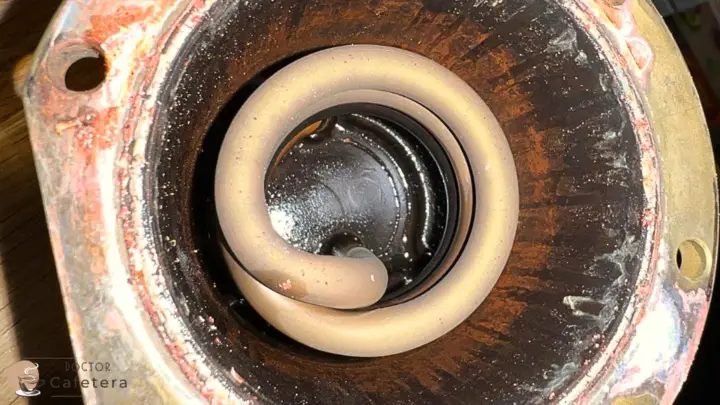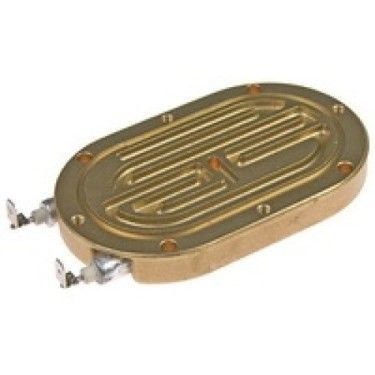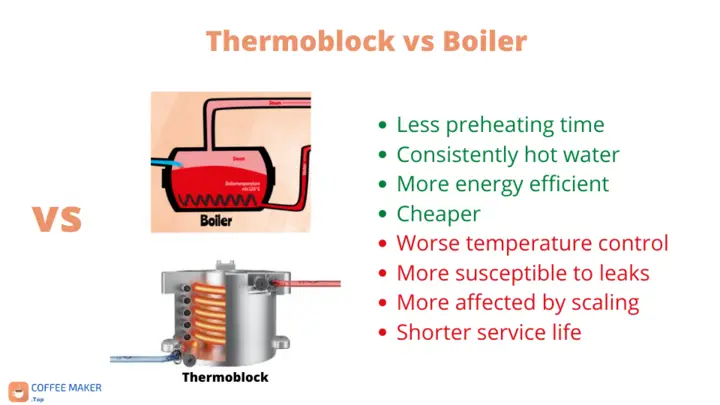The coffee machines use pressurised water and high temperature to prepare coffee. These coffee machines can reach the recommended temperature range of 93º-95ºC using two different heating systems: the boiler and the thermoblock.
The thermoblock system has recently become prevalent in coffee machines due to its superior energy efficiency and cost-effectiveness. Nevertheless, select mid-range and high-end models still employ a boiler.
What is a boiler?
Boilers are enclosed compartments containing a heating element that raises the water temperature, releasing it only during coffee extraction.
Typically, these machines have 250cc boilers, although higher-end models may feature larger 325cc boilers.
Boiler kettles are commonly made of aluminium, steel, or brass. Among these materials, brass is the most commonly used and expensive due to its superior heat retention properties.

What is a Thermoblock
The Thermoblock system extracts water directly from the reservoir and routes it through a sequence of tubes for rapid heating.
In contrast to the traditional boiler, the Thermoblock does not retain water, enabling swift brewing without compromising flavour. By utilizing only the necessary quantity for each cup of coffee, the Thermoblock system contributes to energy and water conservation.

Boiler vs Thermoblock: differences and advantages
Which is better, a boiler or a Thermoblock? Let’s illuminate this question by examining each system’s advantages and disadvantages.
Advantages of Thermoblock
Thermoblock systems offer several advantages over traditional boilers. Let’s explore them in detail:
- Efficient water heating: Unlike boilers, Thermoblocks employ a compact circuit that heats only the precise amount of water required to brew a coffee. This focused heating approach ensures energy efficiency by minimizing water and energy wastage. As a result, Thermoblocks heat water faster and consume less power.
- Freshwater usage: With Thermoblock systems, only freshwater passes through the circuit, eliminating the need for standing or accumulated water. This results in improved water quality and taste for every cup of coffee.
- Faster brewing: Since Thermoblocks heat a smaller quantity of water, they significantly reduce the heating time compared to boilers. Users can enjoy their coffee quicker without compromising on flavour or quality.
- Customized steam production: Some coffee makers equipped with Thermoblocks also include a vaporizer function. This feature allows users to heat the water for steam production on-demand, conserving energy when steam is not needed. Over time, this small energy-saving adds up, contributing to a noticeable reduction in electricity consumption.
- Temperature control: Thermoblocks incorporate two thermistors to regulate the heating process based on the user’s selection. One thermistor sets the water temperature to around 93ºC for coffee preparation, while the other activates heating up to around 124ºC for steam production.
The following diagram provides a visual representation of both systems and highlights the open circuit of the Thermoblock, through which water enters and exits. At the same time, the boiler contains a heating element (represented by the black line) that raises the water temperature according to the thermistor’s instructions:

Advantages of the boiler
Boiler systems offer several advantages over thermoblocks. Let’s explore them in detail:
- Attractive design and higher quality: Coffee machines with boilers often feature more appealing designs and higher-quality construction materials, with stainless steel being the predominant choice. However, this can result in a higher price tag.
- Repairability: Boilers are standalone components that can be easily removed from the coffee maker for repair or maintenance. They can be fixed, polished, or replaced individually if needed. In contrast, Thermoblocks have complex internal designs and are usually replaced entirely rather than repaired, making them less easily fixable.
- Consistent water temperature: Boilers ensure that all the water inside receives the same temperature under any conditions. This is not always true with thermoblocks; purists often notice the difference.
Coffee makers with a boiler
Coffee makers with a boiler efficiently heat water to reach the optimal temperature for making espresso. In most domestic espresso machines, an additional component called a steam wand froths milk using steam.
➡️ The temperature at which steam is generated (around 124º degrees) differs from the ideal temperature for brewing espresso (between 93º and 95º).
To accommodate these different temperatures, coffee makers with a steam wand have single boilers that switch between 93º and 124º degrees. Users must wait for the temperature to decrease accordingly after steaming milk before preparing coffee.
Other espresso machines have a single boiler with a heat exchanger, maintaining a consistent temperature for steaming (around 124º). The temperature only changes when fresh water passes through the heat exchanger tube. This design allows users to prepare coffee and heat milk simultaneously or with minimal delay.
Coffee machines with a single boiler (without a heat exchanger) are more basic and take longer to transition between coffee-making and milk-steaming modes.
Coffee machines with two boilers
Coffee machines with two boilers take espresso machines to the next level. These machines feature two separate boilers, each serving a specific purpose. One boiler is dedicated solely to heating water for coffee at 95º, while the other boiler generates steam for the milk vaporizer at 124º.
Both boilers are always ready to perform their respective functions without any waiting time or resistance adjustments. When the coffee machine is turned on, it needs to heat more water than machines with a single boiler.
Naturally, espresso machines with double boilers are more advanced and come at a higher price than their common single-boiler counterparts.
Conclusions: Thermoblock vs boiler
The key points for a great espresso are high-quality coffee beans and a good grinder. With this winning combination and proper technique, you can achieve a delicious, high-quality espresso even without a coffee maker with a boiler or heat exchanger.
Beyond that, the choice ultimately comes down to personal preference. We have observed that both systems generally yield similar results, each with its advantages and disadvantages.
Importantly, the differences between them do not always significantly impact the taste of the coffee. Moreover, we have found that there is a variety of opinions to suit diverse coffee preferences.
